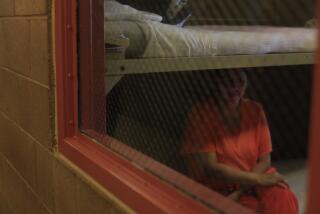Death row inmates casting a wider Net
- Share via
SAN FRANCISCO -- — From the forbidding, steely confines of San Quentin Prison’s death row, scores of California’s most notorious convicts have been reaching out to the free world via the Internet.
Scott Peterson’s Web page features smiling photos of himself with his wife Laci, whom he was found guilty of murdering and dumping into San Francisco Bay while she was pregnant with their unborn son. It also links viewers to his family’s support site, where Peterson has a recent blog posting on his “wrongful conviction.”
Mustachioed Randy Kraft, condemned Orange County slayer of 16 young men, is looking for pen pals. So is convicted Northern California serial killer Charles Ng, who describes himself as shy and offers to sell his wildlife drawings.
Tattooed and muscled Richard Allen Davis, whose abduction and murder of 12-year-old Polly Klaas helped trigger California’s “three strikes” law, is not selling his hobby crafts but wants correspondents.
“I dug my grave -- now I must lay in it,” he says of his life.
Prisoners are barred from direct computer access that officials say could allow them to threaten witnesses or orchestrate crimes. Thanks to supporters and commercial services, however, many of the state’s 673 condemned inmates now have pen-pal postings and personalized Web pages with their writings, artwork and photos of themselves -- often accompanied by declarations of innocence and pleas for friendship and funds.
Although some inmates utilize sites in the U.S., the nonprofit Canadian Coalition Against the Death Penalty has created Web pages or pen-pal ads for more than 100 California death row inmates. The site, unlike some others, is free.
Prisoners’ mail privileges “make it virtually impossible to stop stuff from going out . . .” said Lt. Eric Messick, litigation coordinator at San Quentin. “That is how things get posted.”
Since the mid-1990s, when a condemned inmate’s column called “Deadman Talkin’ ” appeared online, use of the Internet by prisoners has proliferated in California and elsewhere.
While civil libertarians applaud the development as the exercise of free speech by isolated people, victims’ rights activists decry it as an unnecessary affront to the loved ones of those whose suffering led society to lock up these prisoners.
“It’s hurtful,” said Christine Ward, director of the Crime Victims Action Alliance. “They are seeing a [convicted] person going on with their life, but the person they raised or married or knew does not get that opportunity. . . . That murdered person is not coming back.”
Elizabeth Alexander, director of the ACLU’s National Prison Project, said survivors simply should steer clear of websites that would be painful to see. “It does not seem that you can design a limit on the 1st Amendment based on an expectation that victims will seek out something that gives them more pain,” she said.
After the widow of an Arizona murder victim became outraged by the killer’s online personals ad, that state’s legislators passed a law banning inmates from the Internet even through outside contacts. In 2003, a judge declared it unconstitutional.
A year earlier, a judge had barred California prison officials from enforcing a rule prohibiting inmates from receiving materials printed from the Internet -- a measure officials said was partly to prevent encoded messages.
Missouri adopted a rule last year, similar to one in Florida, prohibiting inmates from soliciting pen pals on the Internet, saying that several had been scamming their new friends. Prison spokesman Brian Hauswirth said many solicitations were misleading, and one female prisoner received $10,000 each from several men who thought she loved them.
Randall Berg, an attorney with the Florida Justice Institute who plans to challenge the Sunshine State’s pen-pal solicitation ban, said such rules violate free speech and reduce the odds that prisoners will be able to stay out of prison.
“They can’t use a pen pal [anymore] to help find employment or a place to live,” he said.
Writing to outsiders is beneficial even for death row inmates with slim prospects for freedom, Berg said. “Idleness is the devil’s workshop.”
The Internet essays of condemned inmates provide glimpses of their interests, thoughts and lives. And prisoner art abounds.
Former professional gambler Herbert Coddington, convicted of sexually assaulting two adolescent models and strangling two chaperons in South Lake Tahoe in 1987, used his page to invite people to commission his art.
Ng, found guilty in 1999 of 11 murders at a secluded Calaveras County cabin, said on his Web page that he draws endangered animals that remind him of his own struggle to survive.
“To raise money for my day-to-day items and additional art materials, I would . . . sell a small number of prints,” he wrote.
Officials say inmates are prohibited from conducting a business. But “that is not to say they don’t,” Messick said.
Some prison artwork and correspondence even wind up on auction sites as “murderabilia.” Officials say it is very difficult to tell how the items got there and whether prisoners are profiting.
Peterson, on his page on the Canadian website, announced in 2005 that he no longer would be responding to writers because some were selling his notes. But last month, he launched a blog on his family’s legal defense site.
There, he wrote: “Knowing that there are rational, thoughtful people willing to look at the evidence, and some so kind as to drop notes of good will or send a small donation has a huge positive impact.” By the end of the month, about 100 e-mail expressions of support had been posted.
Many inmates solicit mail on pen-pal sites. A serial killer looking for correspondents described himself as “lonely death row Teddy . . . seeking female teddy bear who is nonjudgmental.”
Many prisoners’ writings do not mention their crimes; others express remorse. Some who deny wrongdoing dissect the evidence and attack police, prosecutors and judges.
“Their saying [that] they were wrongfully convicted is a criticism of the government and . . . is the most central aspect of free speech,” said John Boston, director of the New York City Legal Aid Society’s prisoner rights project.
And there are the short stories of former Crips gang member Steve Champion, on death row for a 1980 double murder during an attempted robbery in Los Angeles County.
In one of his stories, Champion describes the silence and tension among condemned prisoners on days when one of them is to die.
“It is both eerie and sickish,” he wrote, “as if some mysterious and awful sore is readying to discharge itself as the clock ticks down.”
--
--
On latimes.com
Inmates reaching out
See more photos of death row prisoners and their Web pages at latimes.com/california
More to Read
Sign up for Essential California
The most important California stories and recommendations in your inbox every morning.
You may occasionally receive promotional content from the Los Angeles Times.










